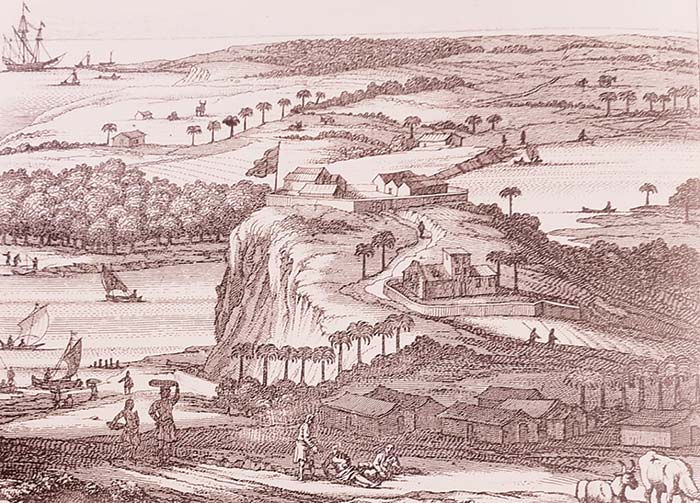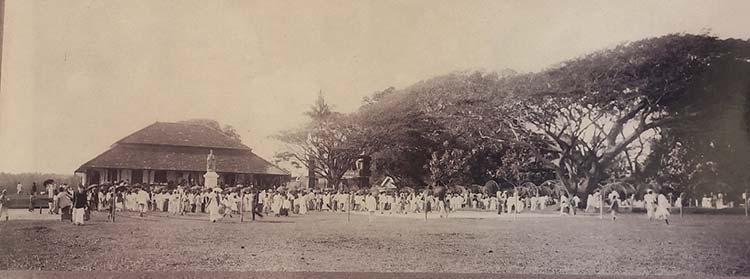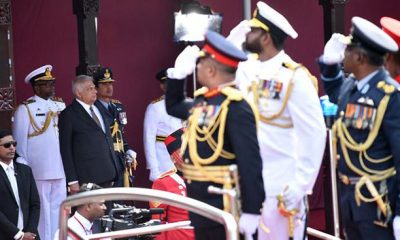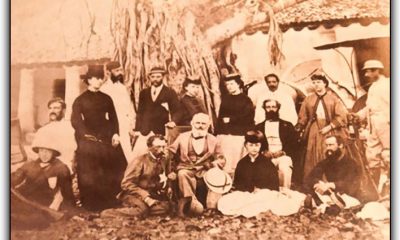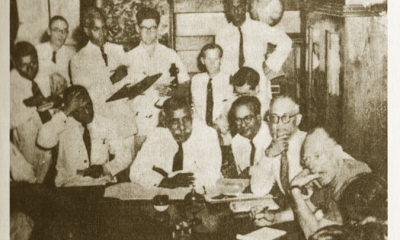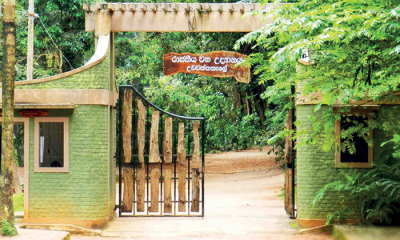Features
Old Kalutara and Lorenz
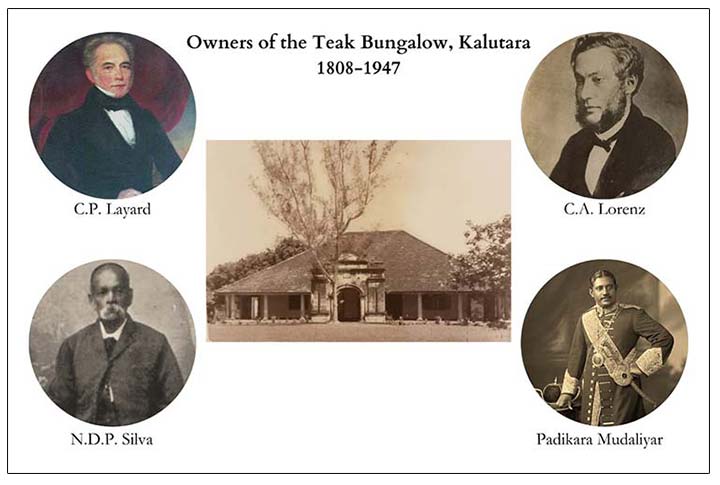
By Avishka Mario Senewiratne
“There is an old Sinhalese saying that ‘happy is the man who is born at Matara and bred at Kalutara.’ Lorenz must have been happy that he was born at Matara and had his well-known holiday home at Kalutara.”- E. H. Van der Waal
Kalutara, 28 miles south of Colombo is perhaps one of the most underrated regions in Sri Lanka. One of my first memories of this palm-fringed coastal city from an aerial view was the thousands of coconut trees, the fabulous Kalu Ganga flowing to the ocean, and the mighty Kalutara Bodhiya as well as old Churches built by European missionaries. The Portuguese realized the strategic and military importance of Kalutara (Caltura as it was known then) and built a fort between 1620 and 1623 demolishing the ancient Gangathilaka Vihare. (see Illustrations and Views of Dutch Ceylon, p. 205).
This was an assignment taken by General Jorge d’Alburquerque. The land of the fort was a hillock on the southern bank of Kalu Ganga. After the Portuguese were ousted, the Dutch under General Gerard Hulft captured Kalutara. The Dutch took a greater interest in this Fort and its environs. Christopher Schweitzer, a German working for the VOC, stated in 1682 that he was one of the 30 soldiers involved in adding ramparts to Kalutara in 1677. In 1672, the Dutch predikant Baldeus noted that “… the Fortress of Caltura situated in a most lovely locality lies near the mouth of a large and broad river close by the sea. This defence is strongly built with double earthen walls…”
Governor Ryckloff Van Goens Sr. took Kalutara more seriously and was assigned to build a road from Kalutara to Colombo, “along which eight men could march abreast, taking with them field guns.” In 1744, Dutch traveler J. W. Heydt commented on the great progress of cinnamon cultivation in Kalutara. In 1796, the Kalutara fort was ceded by British troops under General Stuart.
After many years of disuse, the Kalutara Fort premises were used as the residence of the Government Agent of Kalutara in 1915. In the early 1960s, this land was taken over by the Kalutara Bodhi Trust and a dagoba was erected after nearly 400 years. Many British individuals who served and lived in Ceylon during the 18th century wrote a manifold of books initially targeting the English audience, who was known to be curious about the new British colony.
Captain Robert Percival writes a great detail about Kalutara in his An Account of an Island in 1803. He reveals that the old fort was dilapidated by that time. He makes a special note of the hunting of wild animals, especially fox in Kalutara. Percival writes: “From Pantura (Panadura) to Caltura, a distance of ten miles, the whole country may be considered as one delightful grove; and the road has entirely the appearance of a broad walk through a shady garden… the grateful refreshment such a road affords to a traveller in this sultry climate, can only be conceived by those who have passed from Columbo to Caltura”. (pp. 125-126)
Rev. James Cordiner comments on Kalutara in his 1807 Description of Ceylon: “Here is a small fortification raised upon a mount, commanding the banks of a beautiful river… a neat village, chiefly in one street, built of stone on thatched roofs, inhabited by native Cingalese, and black descendants of native Portuguese. The climate is cool, the place is rural and the situation pleasant.” (p. 174)
Major Jonathan Forbes writes in his Eleven Years in Ceylon, on Kalutara on his way to Colombo, “There is considerable variety of ground and scenery.” (1840, part II, p. 167)
Sir James Emerson Tennent wrote: “Caltura has always been regarded as one of the sanitaria of Ceylon, and as it faces the sea breeze from the south-west, the freshness of its position, combined with the beauty and grandeur of the surrounding scenery, rendered it the favourite resort of the Dutch, and afterwards of the British… from the great extent of the coconut groves which surround it, Caltura is one of the principal places for the distillation of Arrack.” (Tennent, part II, p. 659)
One of the first prominent Europeans to build a country residence in Kalutara was John Rodney, the Colonial Secretary.
Teak Bungalow
Extending up to nine acres and resting on the banks of Kalu Ganga, this opulent property was originally called ‘Mount Layard’. It belonged to Charles Edward Layard (1787-1852), C.C.S., father of Sir C. P. Layard, Government Agent of the Western Province. Layard married a Dutch Burgher lady called Barbara Bridgetina Mooyart. They bore 26 children of which 21 survived infancy. The Layards occupied this house between the years 1808 and 1814, when Charles Layard was the Collector for Kalutara (See Toussaint, J. R., (1935), Annals of the Ceylon Civil Service, p. 59). While residing in Kalutara, Layard and James Anthony Mooyart attempted to cultivate sugar cane. However, the experiment was futile.
J. W. Bennet comments on this in his monumental 1843 tome Ceylon and its Capabilities as follows: “These gentlemen introduced the culture of the sugar cane, but upon too extensive a scale for a first experiment; and, owing to the quantity of iron with which the soil there is almost everywhere impregnated, were unsuccessful.” (p. 34) When Rev. Reginald Heber, the Anglican Bishop of Calcutta visited Ceylon in 1825 he lodged in this house for a few days. Heber wrote the following in his journal:
“Culture, where in a very pretty bungalow belonging to Mr. Layard, commanding a beautiful view of the river and sea we breakfasted’
Commenting on the view of Kalu Ganga from Mount Layard, J. W. Bennet wrote the following in Ceylon and its Capabilities:
“The view from Mount Layard, the country residence of Charles Edward Layard, Esq., on the left bank of the river, is beautiful; but one scarcely knows which of the two reaches of the river to admire most:—the old fort, an island, and the open sea over the sandy ridge, make the view down the river the finest, but for the Indian impression given by the areka trees and coco-nut topes;—but the mellow richness of the scenery up the river towards Gal-Pata, would, to a Cockney, appear a Richmond Hill style of beauty, and of course be in his eyes the most interesting.” (p. 375)
- An old Dutch House in Kalutara by H.W. Cave
- A view of Kalu Ganga from the Teak Bungalow. Photographed by H.W. Cave, 1908
A few years after Layard died in 1852, Lorenz who was by then well-off owing to a sound legal practice purchased “Mount Layard” and re-named it “Teak Bungalow”. This was obviously due to the large number of teak trees on the property. Lorenz bought the adjoining properties bearing coconut trees and paddy fields along with this compound. He named his nephew Edwin Poulier as Superintendent. Poulier was known to have done a good job with the estate. Annually for about six weeks during the Easter recess, Lorenz lodged in Teak Bungalow.
Here he dispensed hospitality and entertained his many friends. Among those friends who visited Lorenz frequently at the Teak Bungalow were two Van Cuylenbergs. One of them, a medical doctor was the father of Sir Hector Van Cuylenberg. Proctor F. S. Thomasz of Kalutara was another frequent visitor. Apart from hosting them, Lorenz would often invite them to shooting parties. In the August 1933 issue of The Ceylon Causerie, E. H. Van der Wall records an interesting statement by an old resident who recalled Lorenz quite well:
“Lorenz frequently visited ‘Teak Bungalow’ for weekends, travelling by stages in his charabanc with two gray horses, and accompanied by a multitude of nephews and nieces. Almost invariably on the day of arrival a lady, who was previously notified, supplied a string-hopper breakfast. This breakfast was served in the large dining room and the guests were seated on mats used for drying paddy. Lorenz also sat on a mat at the head of the party. No knives, spoons or forks were used at the repast, the use of fingers being de rigueur.”
The walls of the Teak Bungalow were adorned by sketches of various people by Lorenz himself. These included District Judge Christoffels de Saram and Dr. Van Cuylenberg. Another interesting story centered around Lorenz is that on one occasion he appeared successfully for a native doctor called Haltota Veda. As a result, the native doctor who was grateful to Lorenz, cultivated his field by the Teak Bungalow for free. On a later occasion, Haltota Veda was made an Arachchi on the recommendation of Lorenz to the Government Agent C. P. Layard. While being lodged here, Lorenz completed his third volume of the Law Reports (Lorenz was the pioneer of writing law reports in Sri Lanka). While suffering various ailments in the latter part of his life, Lorenz came to the Teak Bungalow on several occasions in the belief of recovery from the far-famed climate. Foxes were plentiful around the Teak Bungalow compound and they would often destroy crops and fruit-bearing trees. Observing this Lorenz sketched the following poem:
One Emma and two Alices
Leaving pleasures and palaces,
Are observing Edward Poulier
Shooting at a Vowlia
Teak Bungalow was put on sale after the untimely death of Lorenz in 1872. However, until a buyer was found, this house was rented as the official residence of the Assistant Government Agent of Kalutara. When an attempt by the Government to acquire the Teak Bungalow failed, the Appeal Court held that the property was not required for a public purpose (See The Ceylon Causerie, August 1933, p. 12). Sometime later the business tycoon nicknamed ‘Plumbago King’, N. D. P. Silva purchased the Teak Bungalow and used it as his country house (Twentieth Century Impressions of Ceylon, pp. 591-594). N. D. P. Silva’s son was the Padikara Mudaliyar N. D. Arthur Silva Wijesinghe, who built the Richmond Castle in Kalutara. The reception for his wedding took place at the Teak Bungalow in 1910. This esteemed and popular abode of some of Ceylon’s most celebrated personalities does not exist anymore. In the 1930s the premises of the former Teak Bungalow housed an Excise Warehouse.
Features
The heart-friendly health minister
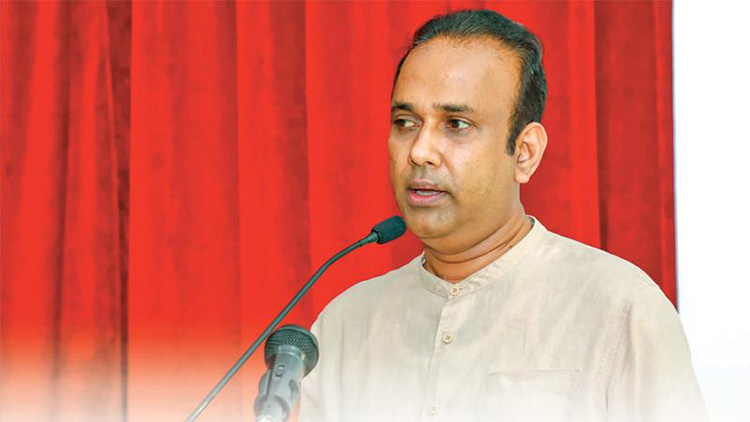
by Dr Gotabhya Ranasinghe
Senior Consultant Cardiologist
National Hospital Sri Lanka
When we sought a meeting with Hon Dr. Ramesh Pathirana, Minister of Health, he graciously cleared his busy schedule to accommodate us. Renowned for his attentive listening and deep understanding, Minister Pathirana is dedicated to advancing the health sector. His openness and transparency exemplify the qualities of an exemplary politician and minister.
Dr. Palitha Mahipala, the current Health Secretary, demonstrates both commendable enthusiasm and unwavering support. This combination of attributes makes him a highly compatible colleague for the esteemed Minister of Health.
Our discussion centered on a project that has been in the works for the past 30 years, one that no other minister had managed to advance.
Minister Pathirana, however, recognized the project’s significance and its potential to revolutionize care for heart patients.
The project involves the construction of a state-of-the-art facility at the premises of the National Hospital Colombo. The project’s location within the premises of the National Hospital underscores its importance and relevance to the healthcare infrastructure of the nation.
This facility will include a cardiology building and a tertiary care center, equipped with the latest technology to handle and treat all types of heart-related conditions and surgeries.
Securing funding was a major milestone for this initiative. Minister Pathirana successfully obtained approval for a $40 billion loan from the Asian Development Bank. With the funding in place, the foundation stone is scheduled to be laid in September this year, and construction will begin in January 2025.
This project guarantees a consistent and uninterrupted supply of stents and related medications for heart patients. As a result, patients will have timely access to essential medical supplies during their treatment and recovery. By securing these critical resources, the project aims to enhance patient outcomes, minimize treatment delays, and maintain the highest standards of cardiac care.
Upon its fruition, this monumental building will serve as a beacon of hope and healing, symbolizing the unwavering dedication to improving patient outcomes and fostering a healthier society.We anticipate a future marked by significant progress and positive outcomes in Sri Lanka’s cardiovascular treatment landscape within the foreseeable timeframe.
Features
A LOVING TRIBUTE TO JESUIT FR. ALOYSIUS PIERIS ON HIS 90th BIRTHDAY

by Fr. Emmanuel Fernando, OMI
Jesuit Fr. Aloysius Pieris (affectionately called Fr. Aloy) celebrated his 90th birthday on April 9, 2024 and I, as the editor of our Oblate Journal, THE MISSIONARY OBLATE had gone to press by that time. Immediately I decided to publish an article, appreciating the untiring selfless services he continues to offer for inter-Faith dialogue, the renewal of the Catholic Church, his concern for the poor and the suffering Sri Lankan masses and to me, the present writer.
It was in 1988, when I was appointed Director of the Oblate Scholastics at Ampitiya by the then Oblate Provincial Fr. Anselm Silva, that I came to know Fr. Aloy more closely. Knowing well his expertise in matters spiritual, theological, Indological and pastoral, and with the collaborative spirit of my companion-formators, our Oblate Scholastics were sent to Tulana, the Research and Encounter Centre, Kelaniya, of which he is the Founder-Director, for ‘exposure-programmes’ on matters spiritual, biblical, theological and pastoral. Some of these dimensions according to my view and that of my companion-formators, were not available at the National Seminary, Ampitiya.
Ever since that time, our Oblate formators/ accompaniers at the Oblate Scholasticate, Ampitiya , have continued to send our Oblate Scholastics to Tulana Centre for deepening their insights and convictions regarding matters needed to serve the people in today’s context. Fr. Aloy also had tried very enthusiastically with the Oblate team headed by Frs. Oswald Firth and Clement Waidyasekara to begin a Theologate, directed by the Religious Congregations in Sri Lanka, for the contextual formation/ accompaniment of their members. It should very well be a desired goal of the Leaders / Provincials of the Religious Congregations.
Besides being a formator/accompanier at the Oblate Scholasticate, I was entrusted also with the task of editing and publishing our Oblate journal, ‘The Missionary Oblate’. To maintain the quality of the journal I continue to depend on Fr. Aloy for his thought-provoking and stimulating articles on Biblical Spirituality, Biblical Theology and Ecclesiology. I am very grateful to him for his generous assistance. Of late, his writings on renewal of the Church, initiated by Pope St. John XX111 and continued by Pope Francis through the Synodal path, published in our Oblate journal, enable our readers to focus their attention also on the needed renewal in the Catholic Church in Sri Lanka. Fr. Aloy appreciated very much the Synodal path adopted by the Jesuit Pope Francis for the renewal of the Church, rooted very much on prayerful discernment. In my Religious and presbyteral life, Fr.Aloy continues to be my spiritual animator / guide and ongoing formator / acccompanier.
Fr. Aloysius Pieris, BA Hons (Lond), LPh (SHC, India), STL (PFT, Naples), PhD (SLU/VC), ThD (Tilburg), D.Ltt (KU), has been one of the eminent Asian theologians well recognized internationally and one who has lectured and held visiting chairs in many universities both in the West and in the East. Many members of Religious Congregations from Asian countries have benefited from his lectures and guidance in the East Asian Pastoral Institute (EAPI) in Manila, Philippines. He had been a Theologian consulted by the Federation of Asian Bishops’ Conferences for many years. During his professorship at the Gregorian University in Rome, he was called to be a member of a special group of advisers on other religions consulted by Pope Paul VI.
Fr. Aloy is the author of more than 30 books and well over 500 Research Papers. Some of his books and articles have been translated and published in several countries. Among those books, one can find the following: 1) The Genesis of an Asian Theology of Liberation (An Autobiographical Excursus on the Art of Theologising in Asia, 2) An Asian Theology of Liberation, 3) Providential Timeliness of Vatican 11 (a long-overdue halt to a scandalous millennium, 4) Give Vatican 11 a chance, 5) Leadership in the Church, 6) Relishing our faith in working for justice (Themes for study and discussion), 7) A Message meant mainly, not exclusively for Jesuits (Background information necessary for helping Francis renew the Church), 8) Lent in Lanka (Reflections and Resolutions, 9) Love meets wisdom (A Christian Experience of Buddhism, 10) Fire and Water 11) God’s Reign for God’s poor, 12) Our Unhiddden Agenda (How we Jesuits work, pray and form our men). He is also the Editor of two journals, Vagdevi, Journal of Religious Reflection and Dialogue, New Series.
Fr. Aloy has a BA in Pali and Sanskrit from the University of London and a Ph.D in Buddhist Philosophy from the University of Sri Lankan, Vidyodaya Campus. On Nov. 23, 2019, he was awarded the prestigious honorary Doctorate of Literature (D.Litt) by the Chancellor of the University of Kelaniya, the Most Venerable Welamitiyawe Dharmakirthi Sri Kusala Dhamma Thera.
Fr. Aloy continues to be a promoter of Gospel values and virtues. Justice as a constitutive dimension of love and social concern for the downtrodden masses are very much noted in his life and work. He had very much appreciated the commitment of the late Fr. Joseph (Joe) Fernando, the National Director of the Social and Economic Centre (SEDEC) for the poor.
In Sri Lanka, a few religious Congregations – the Good Shepherd Sisters, the Christian Brothers, the Marist Brothers and the Oblates – have invited him to animate their members especially during their Provincial Congresses, Chapters and International Conferences. The mainline Christian Churches also have sought his advice and followed his seminars. I, for one, regret very much, that the Sri Lankan authorities of the Catholic Church –today’s Hierarchy—- have not sought Fr.
Aloy’s expertise for the renewal of the Catholic Church in Sri Lanka and thus have not benefited from the immense store of wisdom and insight that he can offer to our local Church while the Sri Lankan bishops who governed the Catholic church in the immediate aftermath of the Second Vatican Council (Edmund Fernando OMI, Anthony de Saram, Leo Nanayakkara OSB, Frank Marcus Fernando, Paul Perera,) visited him and consulted him on many matters. Among the Tamil Bishops, Bishop Rayappu Joseph was keeping close contact with him and Bishop J. Deogupillai hosted him and his team visiting him after the horrible Black July massacre of Tamils.
Features
A fairy tale, success or debacle
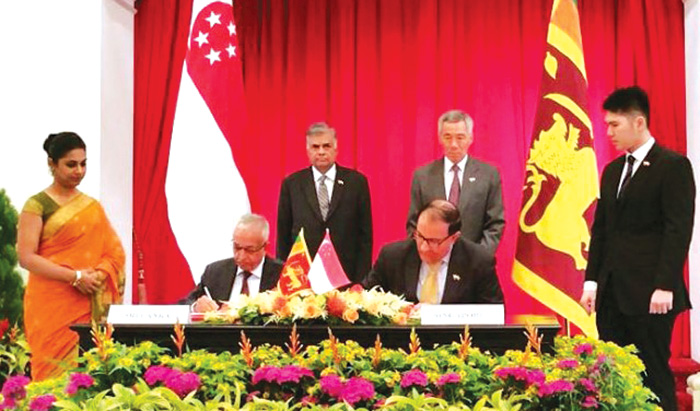
Sri Lanka-Singapore Free Trade Agreement
By Gomi Senadhira
senadhiragomi@gmail.com
“You might tell fairy tales, but the progress of a country cannot be achieved through such narratives. A country cannot be developed by making false promises. The country moved backward because of the electoral promises made by political parties throughout time. We have witnessed that the ultimate result of this is the country becoming bankrupt. Unfortunately, many segments of the population have not come to realize this yet.” – President Ranil Wickremesinghe, 2024 Budget speech
Any Sri Lankan would agree with the above words of President Wickremesinghe on the false promises our politicians and officials make and the fairy tales they narrate which bankrupted this country. So, to understand this, let’s look at one such fairy tale with lots of false promises; Ranil Wickremesinghe’s greatest achievement in the area of international trade and investment promotion during the Yahapalana period, Sri Lanka-Singapore Free Trade Agreement (SLSFTA).
It is appropriate and timely to do it now as Finance Minister Wickremesinghe has just presented to parliament a bill on the National Policy on Economic Transformation which includes the establishment of an Office for International Trade and the Sri Lanka Institute of Economics and International Trade.
Was SLSFTA a “Cleverly negotiated Free Trade Agreement” as stated by the (former) Minister of Development Strategies and International Trade Malik Samarawickrama during the Parliamentary Debate on the SLSFTA in July 2018, or a colossal blunder covered up with lies, false promises, and fairy tales? After SLSFTA was signed there were a number of fairy tales published on this agreement by the Ministry of Development Strategies and International, Institute of Policy Studies, and others.
However, for this article, I would like to limit my comments to the speech by Minister Samarawickrama during the Parliamentary Debate, and the two most important areas in the agreement which were covered up with lies, fairy tales, and false promises, namely: revenue loss for Sri Lanka and Investment from Singapore. On the other important area, “Waste products dumping” I do not want to comment here as I have written extensively on the issue.
1. The revenue loss
During the Parliamentary Debate in July 2018, Minister Samarawickrama stated “…. let me reiterate that this FTA with Singapore has been very cleverly negotiated by us…. The liberalisation programme under this FTA has been carefully designed to have the least impact on domestic industry and revenue collection. We have included all revenue sensitive items in the negative list of items which will not be subject to removal of tariff. Therefore, 97.8% revenue from Customs duty is protected. Our tariff liberalisation will take place over a period of 12-15 years! In fact, the revenue earned through tariffs on goods imported from Singapore last year was Rs. 35 billion.
The revenue loss for over the next 15 years due to the FTA is only Rs. 733 million– which when annualised, on average, is just Rs. 51 million. That is just 0.14% per year! So anyone who claims the Singapore FTA causes revenue loss to the Government cannot do basic arithmetic! Mr. Speaker, in conclusion, I call on my fellow members of this House – don’t mislead the public with baseless criticism that is not grounded in facts. Don’t look at petty politics and use these issues for your own political survival.”
I was surprised to read the minister’s speech because an article published in January 2018 in “The Straits Times“, based on information released by the Singaporean Negotiators stated, “…. With the FTA, tariff savings for Singapore exports are estimated to hit $10 million annually“.
As the annual tariff savings (that is the revenue loss for Sri Lanka) calculated by the Singaporean Negotiators, Singaporean $ 10 million (Sri Lankan rupees 1,200 million in 2018) was way above the rupees’ 733 million revenue loss for 15 years estimated by the Sri Lankan negotiators, it was clear to any observer that one of the parties to the agreement had not done the basic arithmetic!
Six years later, according to a report published by “The Morning” newspaper, speaking at the Committee on Public Finance (COPF) on 7th May 2024, Mr Samarawickrama’s chief trade negotiator K.J. Weerasinghehad had admitted “…. that forecasted revenue loss for the Government of Sri Lanka through the Singapore FTA is Rs. 450 million in 2023 and Rs. 1.3 billion in 2024.”
If these numbers are correct, as tariff liberalisation under the SLSFTA has just started, we will pass Rs 2 billion very soon. Then, the question is how Sri Lanka’s trade negotiators made such a colossal blunder. Didn’t they do their basic arithmetic? If they didn’t know how to do basic arithmetic they should have at least done their basic readings. For example, the headline of the article published in The Straits Times in January 2018 was “Singapore, Sri Lanka sign FTA, annual savings of $10m expected”.
Anyway, as Sri Lanka’s chief negotiator reiterated at the COPF meeting that “…. since 99% of the tariffs in Singapore have zero rates of duty, Sri Lanka has agreed on 80% tariff liberalisation over a period of 15 years while expecting Singapore investments to address the imbalance in trade,” let’s turn towards investment.
Investment from Singapore
In July 2018, speaking during the Parliamentary Debate on the FTA this is what Minister Malik Samarawickrama stated on investment from Singapore, “Already, thanks to this FTA, in just the past two-and-a-half months since the agreement came into effect we have received a proposal from Singapore for investment amounting to $ 14.8 billion in an oil refinery for export of petroleum products. In addition, we have proposals for a steel manufacturing plant for exports ($ 1 billion investment), flour milling plant ($ 50 million), sugar refinery ($ 200 million). This adds up to more than $ 16.05 billion in the pipeline on these projects alone.
And all of these projects will create thousands of more jobs for our people. In principle approval has already been granted by the BOI and the investors are awaiting the release of land the environmental approvals to commence the project.
I request the Opposition and those with vested interests to change their narrow-minded thinking and join us to develop our country. We must always look at what is best for the whole community, not just the few who may oppose. We owe it to our people to courageously take decisions that will change their lives for the better.”
According to the media report I quoted earlier, speaking at the Committee on Public Finance (COPF) Chief Negotiator Weerasinghe has admitted that Sri Lanka was not happy with overall Singapore investments that have come in the past few years in return for the trade liberalisation under the Singapore-Sri Lanka Free Trade Agreement. He has added that between 2021 and 2023 the total investment from Singapore had been around $162 million!
What happened to those projects worth $16 billion negotiated, thanks to the SLSFTA, in just the two-and-a-half months after the agreement came into effect and approved by the BOI? I do not know about the steel manufacturing plant for exports ($ 1 billion investment), flour milling plant ($ 50 million) and sugar refinery ($ 200 million).
However, story of the multibillion-dollar investment in the Petroleum Refinery unfolded in a manner that would qualify it as the best fairy tale with false promises presented by our politicians and the officials, prior to 2019 elections.
Though many Sri Lankans got to know, through the media which repeatedly highlighted a plethora of issues surrounding the project and the questionable credentials of the Singaporean investor, the construction work on the Mirrijiwela Oil Refinery along with the cement factory began on the24th of March 2019 with a bang and Minister Ranil Wickremesinghe and his ministers along with the foreign and local dignitaries laid the foundation stones.
That was few months before the 2019 Presidential elections. Inaugurating the construction work Prime Minister Ranil Wickremesinghe said the projects will create thousands of job opportunities in the area and surrounding districts.
The oil refinery, which was to be built over 200 acres of land, with the capacity to refine 200,000 barrels of crude oil per day, was to generate US$7 billion of exports and create 1,500 direct and 3,000 indirect jobs. The construction of the refinery was to be completed in 44 months. Four years later, in August 2023 the Cabinet of Ministers approved the proposal presented by President Ranil Wickremesinghe to cancel the agreement with the investors of the refinery as the project has not been implemented! Can they explain to the country how much money was wasted to produce that fairy tale?
It is obvious that the President, ministers, and officials had made huge blunders and had deliberately misled the public and the parliament on the revenue loss and potential investment from SLSFTA with fairy tales and false promises.
As the president himself said, a country cannot be developed by making false promises or with fairy tales and these false promises and fairy tales had bankrupted the country. “Unfortunately, many segments of the population have not come to realize this yet”.
(The writer, a specialist and an activist on trade and development issues . )

